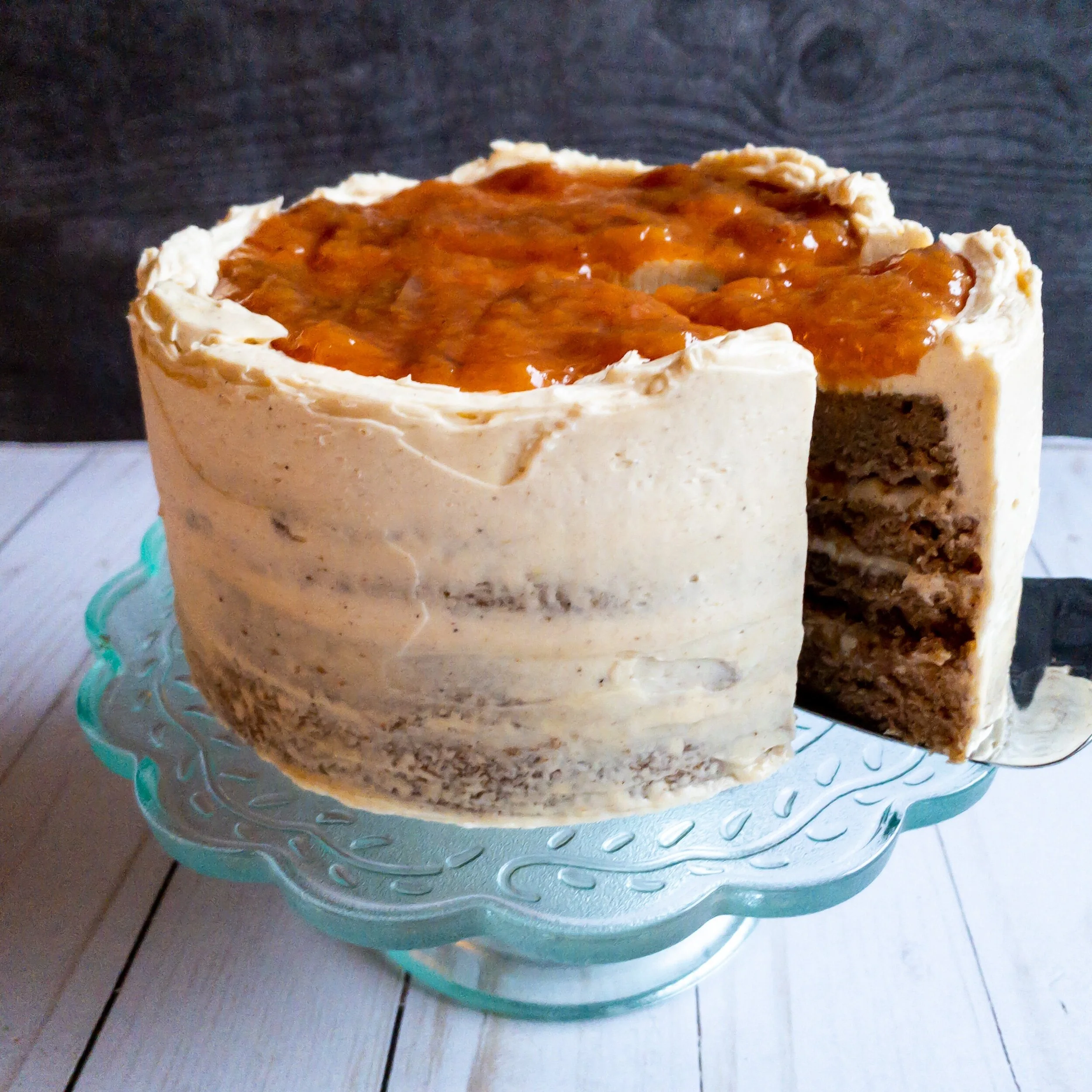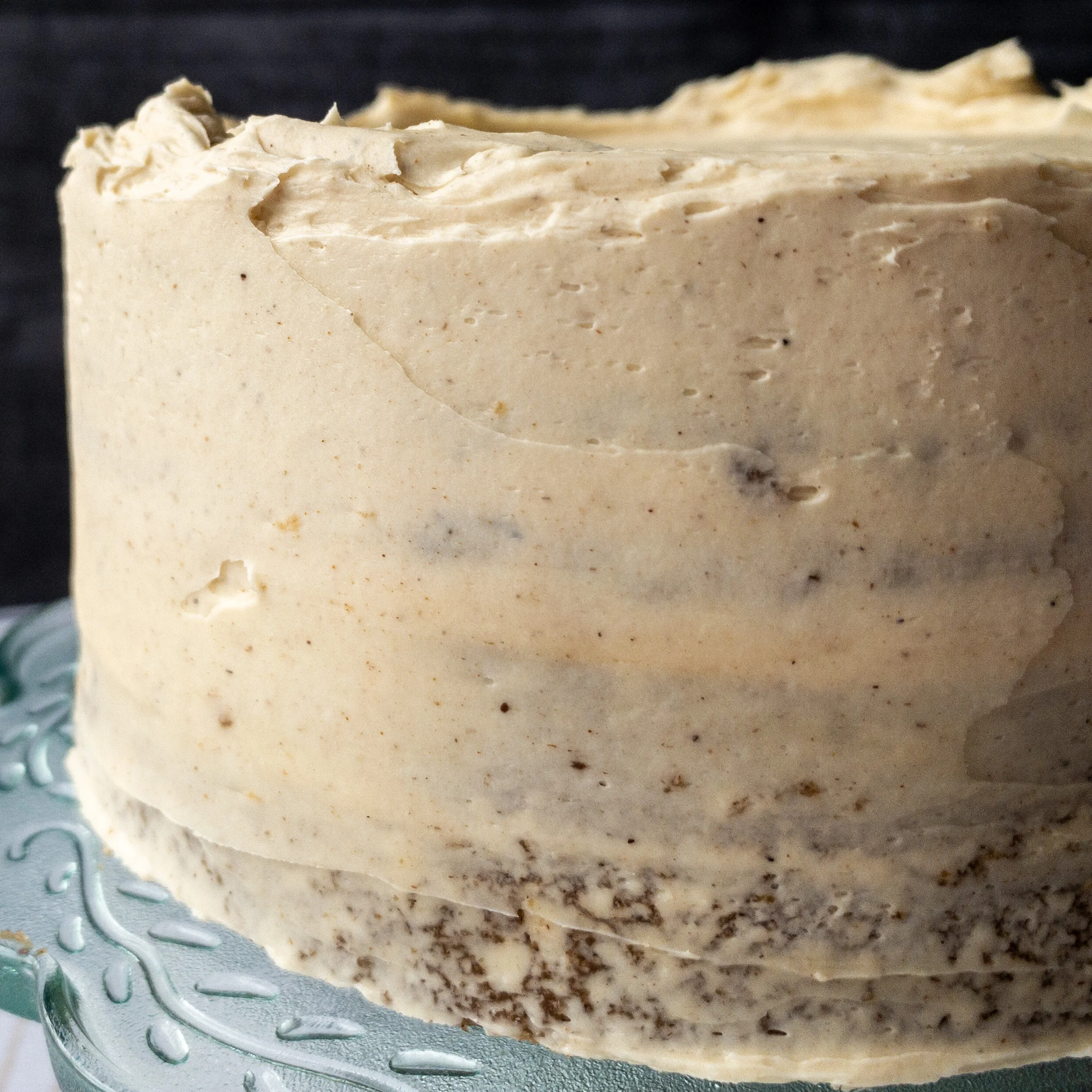Cinnamon Vanilla Bean Buttercream
Rich, earthy vanilla bean complements the hint of cinnamon in this creamy, perfectly sweet buttercream. This frosting is basically fall in a bit and goes with just about any cake!
This post may contain affiliate links from which, at no additional cost to you, I may earn a small commission to keep this site running. Only products I myself would or do use are recommended.
The story
Fun fact: Greeks love cinnamon. It’s a staple in many of their sweet and savory dishes.
Whether I like it or not, I have married into a family of lemons and feta and cinnamon. Luckily, I like all of them. Cinnamon wasn’t always my favorite, but I’ve come around to it, even in things like my pasta sauce (crazy, I know—but if you’re Greek, you get it).
In fact, once we got fancy, special order Ceylon cinnamon, I found I like it even more. Good cinnamon has an amazing taste. Almost a zing or tang to it, and it tastes so much more fresh than the typical cinnamon flavors I grew up with.
While this frosting isn’t anything particularly unique, I like the combination of a noticeable cinnamon punch balanced by creamy vanilla bean paste. Plus, if you follow the directions (no judgment if you prefer your own method, I know I like to go rogue with recipes), you’ll get a fluffy frosting that’s a sweet complement to any cake.
I made this particular batch to go with my ginger bourbon peach compote as a filling for my browned butter cinnamon cake. But it would be spectacular on its own. In fact, I’ve also made it with my chocolate cake, adding 1/2 to 1 tablespoon cinnamon and 1/4 teaspoon ground cayenne pepper to the cake. It makes an amazing Mexican chocolate cake!
Tips for this recipe
Classic American buttercream is pretty straightforward and easy to troubleshoot. But, there are some tricks to take it up a notch and have super fluffy, smooth, easy-to-work-with buttercream.
Add heavy cream slowly
This is the most important tip I have. If you add too much heavy cream, it’s hard to recover from. Many recipes suggest adding it one tablespoon at a time, but I do even less, using only a splash at a time.
Sift powdered sugar if you live in humidity
Or, if you’ve had issues with lumpy frosting. Usually, the method of adding 1 cup of powdered sugar at a time and fully mixing each time will eliminate lumps. But depending on your climate or the brand of powdered sugar, you may still struggle to get a smooth frosting. If that’s the case, try sifting the powdered sugar as you add it.
Slowly increase speed to high with each addition of sugar
This is mostly to help with the messy puff of sugar when you turn on the mixer. Start on low then slowly increase speed to high until it’s smooth. I probably mix for a total of 20-30 seconds after each addition.
Scrape down bowl at least twice mid-mix, then at end
You want to make sure there’s no streaks of butter or clumps of powdered sugar in your finished product. Scraping the bowl gets tedious, so I usually only do it a couple times while mixing, then again once I am happy with the taste and texture and am ready to do the final whip.
Add salt, vanilla, and cinnamon toward the end
This is actually a key step. I used to be lazy and just add things to my buttercream when I felt like it. Then I had terrible luck with a mascarpone buttercream. Usually, you’ll have the best luck if you cream the butter, add at least half your sugar, then add any other ingredients like vanilla and cinnamon. Of course, there are times when you mix something in sooner, like with the peanut butter frosting in my OMG cake. So, basically, follow the directions. 😊
Don’t skip the whip!
This step serves a few purposes. It helps lighten the color of the frosting, regardless of the kind of butter you used. It makes the frosting silky and creamy, while also fluffy. And it creates and smooth, workable buttercream that’s easy to frost a cake with.
Use quality cinnamon
We have fancy Ceylon cinnamon from I don’t know where. Which is rich and almost tangy and I love it. But as long as you have a good, high quality cinnamon (and ideally from Saigon, because apparently that matters?), you’ll get a rich cinnamon flavor in your frosting.
My buttercream tools
Here are my must-have tools I use for making this buttercream. Affiliate links provided.
Cinnamon Vanilla Bean Buttercream
- total time: 10-15 minutes
Yields: about 2.5-3 cups, enough to fill and frost an 8” cake or 24 cupcakes
Ingredients:
- 3 sticks (12 ounces) unsalted European style butter, like Kerrygold—room temperature
- 4-5 cups powdered sugar
- 1-2 teaspoons cinnamon, to taste (I used 2)
- 1-2 teaspoons vanilla bean paste (I used 1 ½—can sub equal amounts or a tad more of pure vanilla extract)
- ⅛ teaspoon fine ground sea salt
- 2-4 tablespoons heavy whipping cream
Instructions:
- Make sure butter is just at room temperature, where you get some resistance when you press into it but it’s not greasy or shiny or melty. Place into the bowl of your stand mixer or a large mixing bowl. With the paddle attachment (or handheld beaters), beat butter on high until smooth, about 1 minute.
- Add powdered sugar, about 1 cup at a time. Start at low then increase speed slowly to high, beating until smooth each time. Scrape down at least twice while adding sugar.
- After adding ½ to ⅔ of the powdered sugar, add the cinnamon, vanilla bean paste, salt, and a splash of heavy cream (about a teaspoon). Add the smallest amounts first, then taste to see if you want more. Use the same process of mixing on low then slowly increasing speed as it blends. Scrape down bowl, taste to be sure you’re happy with the cinnamon and vanilla flavor, then continue adding powdered sugar.
- After your next addition of powdered sugar, taste to see if it’s sweet enough. Once it is, you’ll add heavy cream a splash at a time until it’s smooth and easily spreadable. If you’re happy with the sweetness and consistency after only 4 cups, you’ll add less heavy cream. If you need the full 5 cups (or more, depending on your needs/climate—just don’t go over 6), you’ll likely use the full amount of heavy cream. Just add it in small increments to prevent a loose frosting.
- Once the taste, consistency, and smoothness/spreadability are to your liking, scrape bowl one more time. Turn the mixer to medium-high or high (I honestly do both, I’ve seen no difference) and let it mix for 3-5 minutes. Once the frosting is light (texture and color) and fluffy, you need to release the large air bubbles created by that final whip. Either turn the mixer to low for 1-2 minutes or stir vigorously with a rubber spatula or wooden spoon for 1 minute.
Frost cake and enjoy!
Frosting will keep at room temperature overnight, refrigerated for 2 weeks, or frozen for 2 months. If using chilled/frozen frosting, let come to room temperature then mix quickly on high to smooth out. Frosted cakes last on the counter 3-5 days, unless otherwise noted by cake recipe.
















